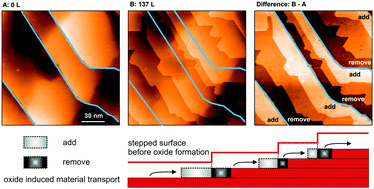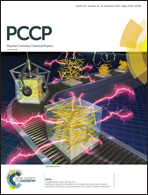Imaging the confined surface oxidation of Ni3Al(111) by in situ high temperature scanning tunneling microscopy†
Abstract
The initial oxidation of Ni3Al(111) was imaged by in situ scanning tunneling microscopy (STM) at 700–750 K. At 740 K ± 10 K a moiré structure is formed as the major surface phase: high resolution STM data atomically resolve a top hexagonal lattice with a lattice constant of 2.93 ± 0.01 Å aligned or slightly rotated with respect to the substrate. Auger electron spectra acquired from the surface phase identify Al atoms in an oxidic environment together with Ni atoms unaffected by the oxidation of the Ni3Al(111) surface. A special mass balance analysis applied to STM images recorded during formation of the moiré structure allowed to extract the metal content of the surface phase. The moiré phase can be attributed to a single O/Al double layer of α-Al2O3 ontop of the Ni3Al(111) crystal. The surface double layer is laterally expanded by ∼7% with respect to α-Al2O3 and, relating to the next nearest neighbor distance of the substrate of 2.52 Å, it contains 0.73 ML oxygen and 0.49 ML aluminium atoms. The building principle of the surface phase is almost identical to the one of the reported Oi/Ali interface layer of the so called  surface oxide, except for its rotational alignment with respect to the substrate as shown in a careful moiré analysis. It could be shown that this thinnest possible surface aluminum oxide layer is formed due to kinetic restrictions: the oxide grows within the first layer of the Ni3Al(111) surface ejecting 0.5 ML surface metal atoms, which are then converted into the surface oxide laterally separated at the ascending step edge of the same terrace. While the formation of the surface oxide is kinetically hindered most likely by the availability of Al adatoms, all rearrangement processes required for the surface oxide formation on each terrace are not rate limiting as identified by in situ STM. Instead, the local oxide growth rather follows the kinetics driven by the adsorption probability of the impinging oxygen molecules and provides the possibility to entirely cover whole Ni3Al(111) surface.
surface oxide, except for its rotational alignment with respect to the substrate as shown in a careful moiré analysis. It could be shown that this thinnest possible surface aluminum oxide layer is formed due to kinetic restrictions: the oxide grows within the first layer of the Ni3Al(111) surface ejecting 0.5 ML surface metal atoms, which are then converted into the surface oxide laterally separated at the ascending step edge of the same terrace. While the formation of the surface oxide is kinetically hindered most likely by the availability of Al adatoms, all rearrangement processes required for the surface oxide formation on each terrace are not rate limiting as identified by in situ STM. Instead, the local oxide growth rather follows the kinetics driven by the adsorption probability of the impinging oxygen molecules and provides the possibility to entirely cover whole Ni3Al(111) surface.



 Please wait while we load your content...
Please wait while we load your content...